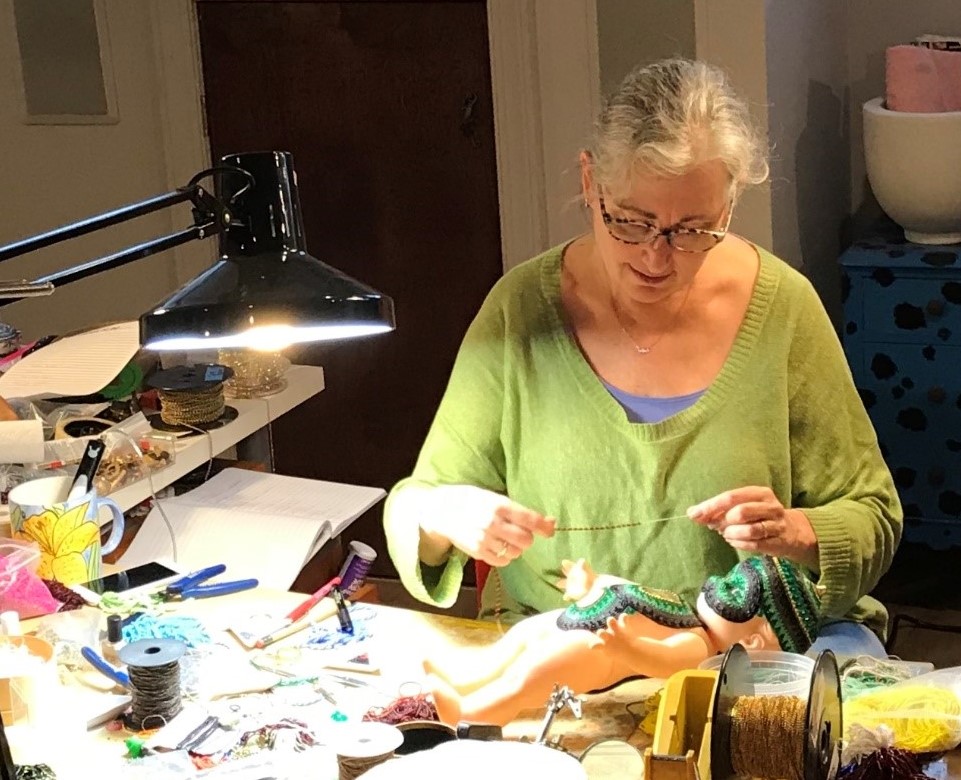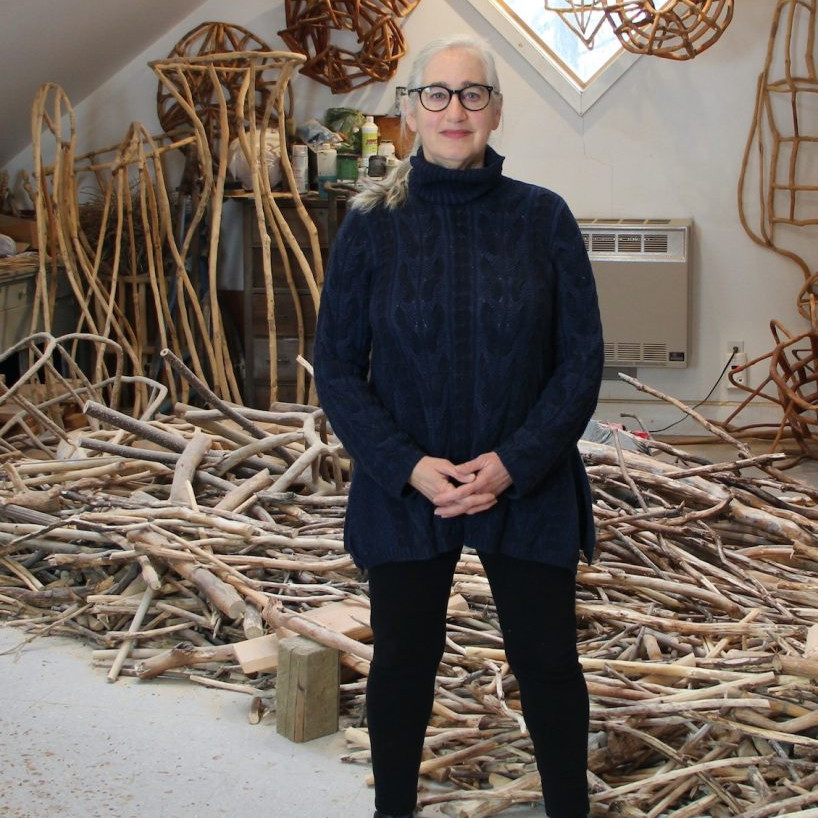Jan Huling Bead Artist - New York, USA
Jan Huling, New York, USA
Beads, beads and more beads make up the art by Jan Huling.
Zoneone Arts brings Jan Huling to you…
What lead you to beads?
My sister came to visit me from Seattle years ago and brought a Pez dispenser that she had beaded. I thought it was so funny and adorable that I wanted to try to bead something as well. I started off with kazoos. The difference between what I was doing and what my sister had done was that I didn’t follow the basic colour of the object, I liked using pattern right off the bat
Discuss the use of repeated patterns in your work.
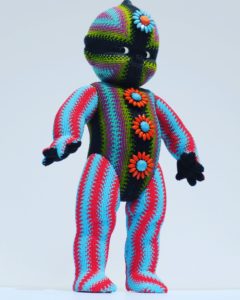
Kewpies – 16”x9”x5”
How do you see the marriage of craft and art in your work?
This is a very difficult question, the line between craft and art is so subjective. I suppose the vision is the art and the construction is the craft. But certainly for what I do, they are two sides of the same coin.
Discuss the planning techniques you use, before even the first bead goes on.
I don’t plan my work at all. I simply find an object or substrate that engages me and jump in. I might have a story I want to tell, but the colours and patterning come about as I go along, one line of beads inspiring the next. I was a commercial artist for many years and had to design to please a client. Now I please myself and if other folks like my work, I’m happy. I have a lot of confidence in my own vision and that allows me to “bead without a net” and just see what happens. I’ve rarely been disappointed in the results.
Discuss this in relations to one of your ‘Kewpie’ forms.
One day when I was still working as a commercial artist, I was in a client’s supply closet and found a large dusty box that had been stored in there for years. I pulled it off the shelf, opened it up and found six brand new Kewpie dolls, still in their boxes! Needless to say, they all came home with me. They were so darling, their form so simple and satisfying, the look in their eyes so mischievous, I fell madly in love with them. I had covered a few toys at that time, notably a My Little Pony, and had discovered how covering a shape entirely allowed me to see the elegance of a well designed form.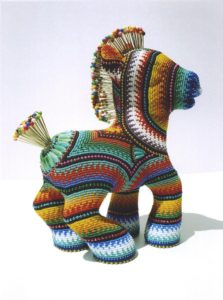
Pony, 9.25”x8”x3.5”
And in finding those six Kewpies, I was inspired to think of them as a series. Even though many have sold individually, a few collectors have multiples.
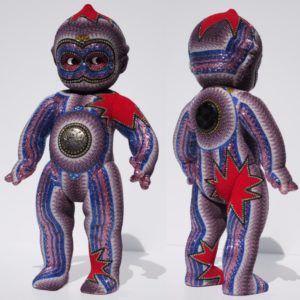
Kewpies – 16”x9”x5”
Can you tell us the history of a ‘Kewpie’?
This is from Wikipedia – Kewpie is a brand of dolls and figurines that were conceived as comic strip characters by cartoonist Rose O’Neill. The illustrated cartoons, appearing as baby cupid characters, began to gain popularity after the publication of O’Neill’s comic strips in 1909, and O’Neill began to illustrate and sell paper doll versions of the Kewpies. The characters were first produced as bisque dolls in Waltershausen, Germany, beginning in 1912, and became extremely popular in the early 20th century
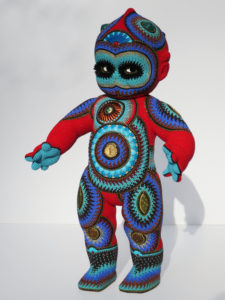
Kewpies – 16”x9”x5”
You have had a residency in Mexico. How did this, either expand or alter you work.
I’ve been lucky enough to have travelled extensively in Mexico, a country that I dearly love and have been inspired by. The residency at 360 Xochi Quetzal, my first, was very special to me particularly because of the wonderful people I met there. I was just coming off, of an extremely busy and emotional year and really needed the space to recharge. I spent the month thinking about my work and getting my head around grant writing as well as working with a Huichol Indian friend.
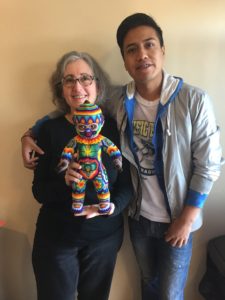
The Huichols are a Mexican tribe and one of the art forms of which they specialize is covering objects with glass seed beads. Like I do. But not. While I have been accused of appropriating this native work, we actually have completely different techniques and artistic vision. I wanted to put an end to these accusations and so I brought my Huichol friend, Xauleme Carrillo, a Kewpie doll to cover in his style and I covered a typically Huichol shape, a jaguar head, in mine. It was delightful to us both to see how the other one approached the work.
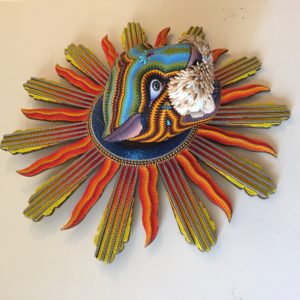
Jaguar Head – 25”x25”x8.5”
Discuss Das Bug using a detail image / images to show the complexity of your work.
Das Bug was so massive that I knew I would want to incorporate many different patterns to not only keep myself interested as I worked, but also to make the final piece exciting and surprising to look at. I love making paisleys and did that down his back and a stripe just goes with everything. But, as I said, nothing was planned out ahead of time.
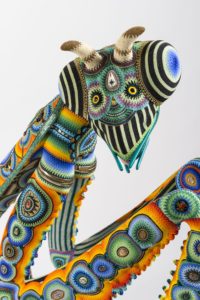
Das Bug, Detail – 61” x 110”x 59”
Discuss Das Bug.
Das Bug is an eight foot long beaded praying mantis.
I found the substrate online made by a mannequin manufacture and knew immediately that I had to cover him. Of course, seeing him on my computer screen and having a gigantic bug set up in my living room where two very different things and I was so intimidated by his size that I kept putting him off!
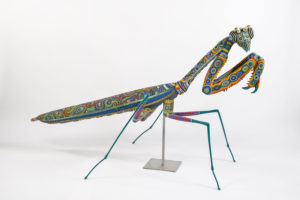
Das Bug, Detail – 61” x 110”x 59”
When I finally decided to jump in, I had a lot of fun. He took about seven months to complete.
How did this work evolve?
When I go into my studio in the morning, I want to be surprised. I don’t want to have a clear idea of what I’ll be working on at the end of the day. My work is so meticulous and I work on things so intensely and for so long, particularly Das Bug, that if I knew what I was going to do and what it would end up looking like, I’d be bored to death. The work itself evolves. It tells me what it wants. I listen.
Are there other bugs?
I actually wish I could find more bugs in that massive scale, but I’ve had no luck so far. I really love insects, particularly praying mantises, along with bats they are my “power animals”. I have beaded beetles, real ones!
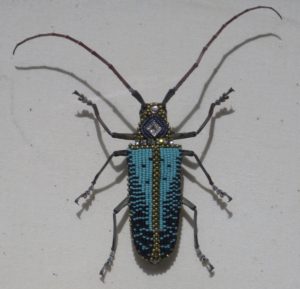
Alexander Beetle, 4”x4.5”
Explain about the different types of beads available and why you choose, Czech glass beads for your work?
There are different kinds of seed beads, the ones from Japan are very beautiful and absolutely perfect, each bead exactly like the next. The Czech beads are imperfect, which is why I love them so much. Some are thick, some very thin. Some are squished on one side and perfect for filling an odd space. I love how very human and warm they are. The Japanese beads are great for weaving and jewellery, but perfection has never been my goal.
Comment on the care needed for your pieces post sale.
My work is delicate, but likes to be dusted with a nice soft dry paintbrush.
Can you expand on your involvement at AVAM?
What a thrill and an honor it was so be in a show at the American Visionary Art Museum! My fellow beadists, Nancy Josephson, Betsy Youngquist and I had been wanting to show our work together for some time. Nancy had worked on several shows at AVAM and has a great working relationship with their director, Rebecca Hoffberger, so she approached Rebecca with our proposal. Happily, our ideas fit in nicely with the museum’s theme of Mystery.
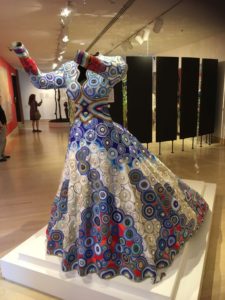
The Gown: Affinity – 62”x59”x81”
It is mind blowing the number of beads in Affinity. Discuss one small detail and a larger detail to show the intricate bead work.
Perhaps I should begin by telling how The Gown:Affinity came into being. I had gone to see the live action Disney film, Cinderella, and was enchanted! I came home and drew gown after gown, twirling and dancing and thought it would be great fun to bead one. So, I called my pal Nancy to tell her about it. She said, well, yes, that’s cool, but why? What does it mean? Why should we care? Good questions. I decided to put it on the back burner.
About a year later, my mother died. She had been a needlework artist, mainly a quilter, and a huge influence and inspiration throughout my life. When I got back into my studio after her death, I started thinking about the gown again and I realized what it meant. The gown was in my attic, it was the wedding gown that my mother and her two sisters had been married in. It was the gown that I’d been married in.
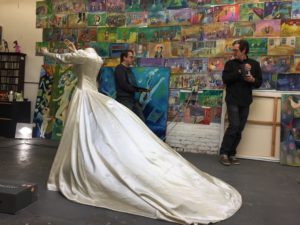
The first problem was how to solidify the dress so that I could work on it. My husband and I discussed it for weeks before I realized that the only thing that made sense was 3D printing. This was a first for me, so it took a bit of research. We ended up staging the gown by putting it on a headless mannequin and stuffing the skirt with boxes and fabric until I had the shape I wanted. Then it was scanned and those computer files were sent to Voodoo Manufacturing in Brooklyn where they have about 150 smallish 3D printers.
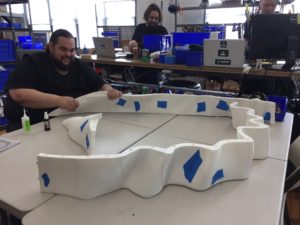
Over the next several weeks, the gown was printed out in 260 Lego-like bricks which were then assembled into a life size piece.
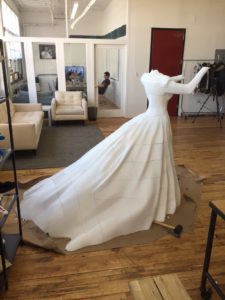
Then the real fun began! I knew that blue would be the major colour, it was my mom’s favourite. While I was gathering my blue beads together I started looking at one of Mom’s quilts which is mostly blue and red, a combination that was not one that I’d usually choose, but which challenged me to go beyond myself. I wanted my mom’s voice to be heard.
A motive that can be seen throughout my work is the mandala. I love to use a flat back cabochon and bead around it to make a flat circle of pattern.
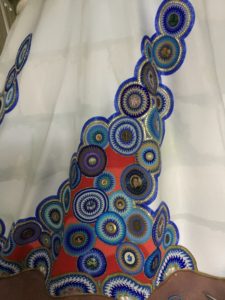
The Gown: Affinity, detail
For Affinity I used a lot of cabochons that were symbolic of my mother, her monogrammed pin, symbols of places she had travelled to and loved, J’s for my sister and brothers and me, tokens from her father’s oil business.
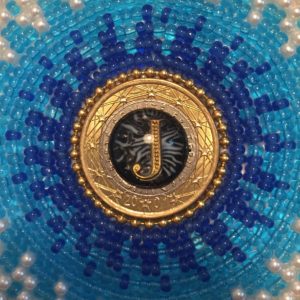
I also made my own cabochons by fitting photos into bezels and covering them with clear resin. My dear sweet cat died while I was working on the gown, so she’s represented in there. For fun, I put a Batman symbol on the gown and to my shock and sadness, Adam West (who played Batman on tv during my childhood) died the next day!
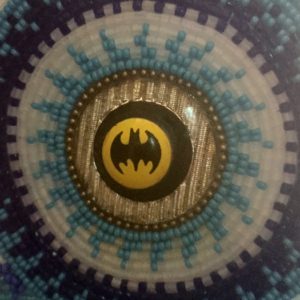
Very sadly, I am the only wearer of the Gown still alive. I would give anything to be able to show it to my mother and my two aunts.
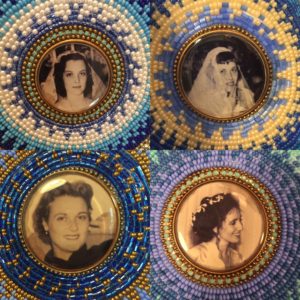
The Gown: Affinity, detail
But while I was working on it, I could feel my mom’s presence so strongly and I felt her pride and love in a way that, well, changed me.

The Gown: Affinity, – 62”x59”x81”
When she first made her presence known to me, I was listening to one of her favourite albums, Affinity by the Oscar Peterson Trio. I found the title so appropriate that I choose to use it in my title.
What is the life of Affinity.
Affinity spent her first year at AVAM and now she is set up at the Pen + Brush Gallery in New York City in a show that is opening next week and closes on October 27th. After that she’ll be in an exhibit called New Directions in Fiber Art at the Montclair Art Museum in New Jersey. And after that? I don’t know.
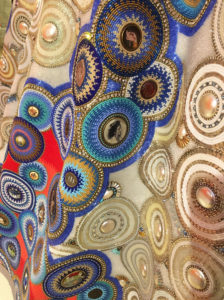
The Gown: Affinity, detail
I created Affinity in my home studio in Hoboken. She had to get through a few sets of double doors to get out of the house, we even had to remove some doors!
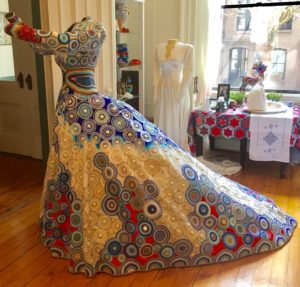
The Gown: Affinity, – 62”x59”x81”
We recently moved to a loft in Jersey City that doesn’t have double doors or any other way to get her in here, so I really must find shows, one after the other, for her. Or sell her. Or, ideally, have her permanently placed in a museum.
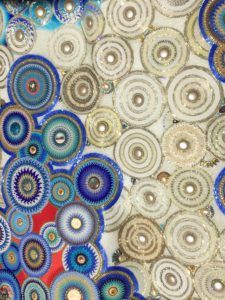
The Gown: Affinity, detail
How do you top this? What is next to come from your studio?
Good question! I’m hoping to create a bunch of animal-esque pieces that will work together as an installation but will still be able to stand alone as a cohesive works of art. I’d like to use substrates in a variety of sizes for this.
I’ve really enjoyed going big, the problem of course is that most collectors don’t want a huge expensive beaded sculpture, imagine that! Also, I work alone, so my gallerists need me to keep churning out work that can be sold rather that hole myself up for a couple of years to put together a collection.
Contact details:
Jan Huling
On instagram @janhulingbeads
Represented by the Duane Reed Gallery
Jan Huling, New York, USA
Think a colleague or friend could benefit from this interview?
Knowledge is one of the biggest assets in any business. So why not forward this on to your friends and colleagues so they too can start taking advantage of the insightful information the artist has given?
Other artists you may be interested in:


